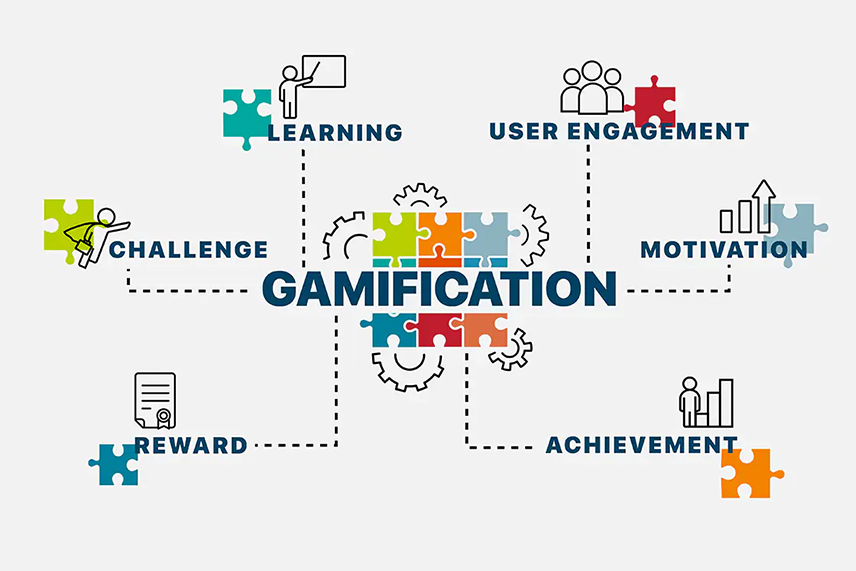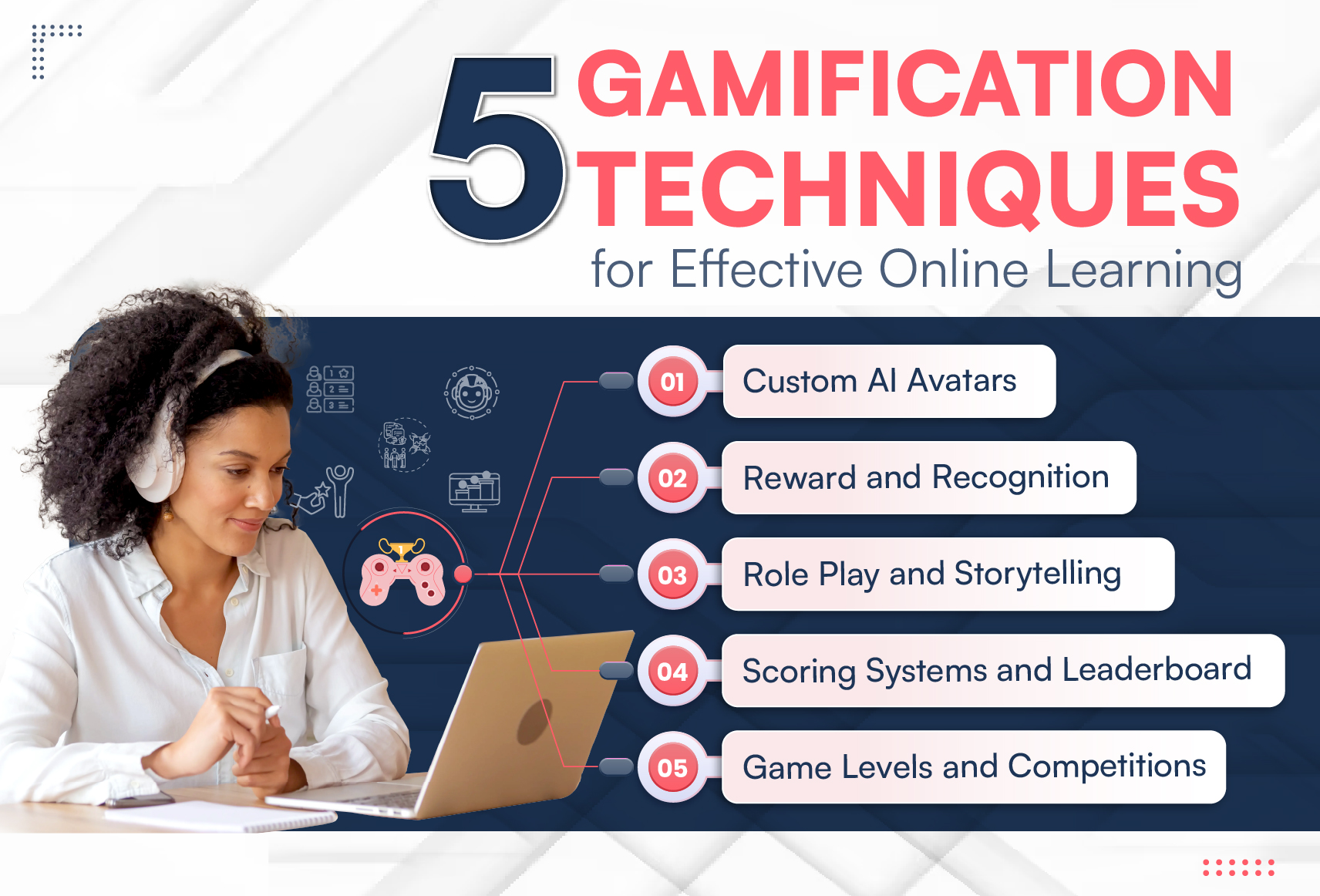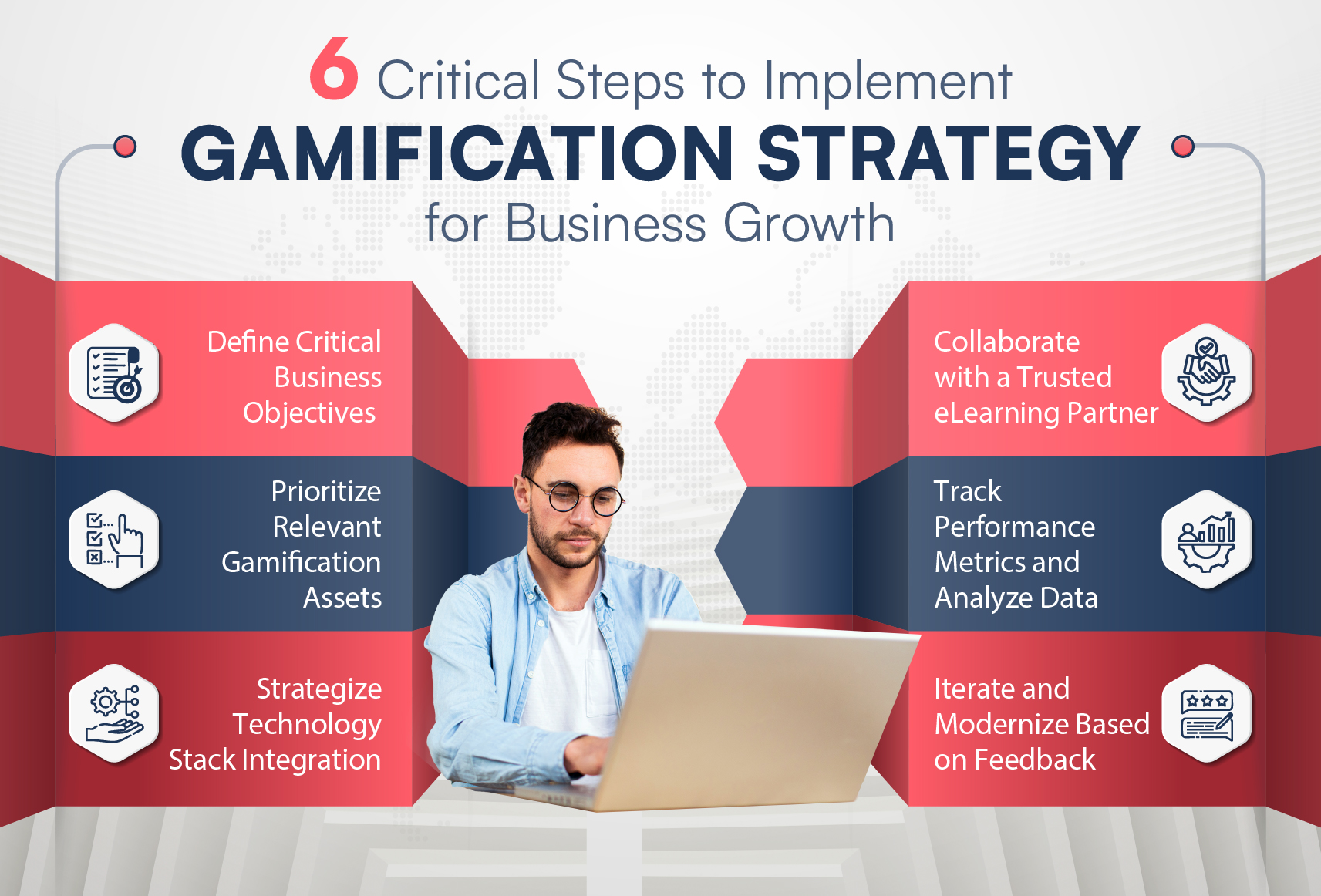
Implementing an effective gamification strategy in eLearning is a powerful way to improve knowledge retention. It involves the use of unique gaming techniques and elements to increase the learner’s participation and stimulate their interest.
Gamification is also proven to be useful in increasing collaboration between learners, when applicable, and enhance their cognitive abilities. In fact, the rising inclusion of gamification in eLearning is a top reason for the latter’s market growth.
Well-designed gamified content focuses on leveraging intrinsic motivating factors in the user to encourage them in the learning process. For example, the leaderboard is one type of game design that challenges users to compete against one another and finish the task.
Then there are reward programs like badges and points to push learners to keep learning. Gamification creates an emotional connection between the learners and the content. Surprise elements and hidden challenges keep up the engagement levels with the content and ensure course completion.
That said, there are different gamification elements that incentivize learners to perform better and induce a positive learning attitude. As gamification analyst Karl Kapp rightly puts it, “Gamification is the cover to add the interactivity, engagement, and immersion that leads to good learning.”
Let’s look at the key aspects of creating a gamification strategy.
What is Gamification?
Gamification is adding game mechanics to a UI using instructional content. It involves repurposing information that leverages game motivations.
According to Dr. Vikas Joshi, Founder & CEO, Harbinger Group, applying gaming aspects to an otherwise mundane process is called gamification. Experts say improving outcomes and increasing involvement are the core purpose of gamification. Gamification is observed to gain a lot of traction with the growing adoption of new learning technologies.
Everyone is probably more familiar with gamified learning than they realize. Gamification is already a common practice, even if it isn’t immediately acknowledged. Any company that wants to improve employee engagement and satisfaction should consider implementing gamification in L&D.
Listen to our Power Hour, What Businesses Need to Know about Gamification in Learning, if you are not aware of the aspects to consider while creating gamified content or how gamifying content works.
While some of the games may be animated, they need not be as complicated or fancy every time. One can apply simple strategies and frameworks as the starting point. A beautiful thing about gamification is that it provides the creators with varied approaches that can be easily adopted.
Scores, leaderboards, quizzes, badges, leveling, challenges, progress bars, rewards, and timers are some of the specialized and widely used gamification elements. Some well-known brands like Nike, Starbucks, Duolingo, and Fitbit have made gamification an intrinsic part of their offerings.
Gamification is not just a buzzword. Organizations shouldn’t overlook the benefits of gamification in corporate training and learning.
Top 8 Gamification Strategies Businesses Can Choose From
There is no doubt that a robust gamification strategy motivates user participation and boosts engagement. Also, gamified environments can elevate learner experience to the next level.
Here are the top 8 gamification strategies which can be deployed to achieve desired training goals.
1. Use of Virtual/ Simulated Environment
Integrating task-based simulations in the training program, can help learners to polish their skills and get solutions to problems they most often would encounter in the real world of business.
Employees that go through such trainings are well trained to avoid traps and have crucial tips that are less likely to fail in the real world.
It is easier for employees to add to their skills through animated or gamified training options.
Pro Tip: Simulations should be designed to mirror real challenges, they should be competitive, use of catchy and relevant images must be considered to enhance learner engagement and experience.
2. Address short attention span
Game mechanics can be leveraged to make learning more meaningful by breaking it down into smaller, easily accessible, and consumable chunks, to address the forgetting curve. Games can be strategically used to divide training into small sessions enabling learners to stay engaged and respond positively.
3. Deploy Gamification for Active Learning
Active learning is a great way to kill boredom and encourage learners. This can be done through various activities such as group discussions, case studies, events, but gamification is one of the best ways to bring the best out of active learning.
Using the points mentioned below, you can use the power of gamification to foster an environment of active learning in the organization:
- Know your learners
- Address their anxieties and fears
- Let learners take control
- Add elements to prevent monotony
- Use familiar characters, case studies and stories
4. Do Not Overate Rewards
We agree that rewards are a great way to attract learners to leverage the power of gamification to skill, upskill, cross-skill, or simply stay updated with knowledge needed to perform and stay ahead in a corporate set up.
However, if learners participate in such learning programs only for rewards is a fallacy. Remember the best corporate gamification program is primarily about the competition and thrill factor. So, make sure to strike a balance and not only focus on rewards.
5. Celebrate Everyone Who Participates
Celebrating the fact that we are all winners will take your gamification strategy a long way. It is wise to measure performance based on participation and praise the efforts of people who made those efforts.
After all, gamification in business is all about teamwork.
6. Foster a continuous Learning Environment
Gamification can be used to foster a continuous learning environment by incorporating game elements, such as badges, leaderboards, and rewards, into training activities. This approach motivates learners, enhances engagement, and encourages them to pursue knowledge willingly, thereby promoting ongoing learning and skill development.
7. Storytelling and Narratives
Integrate storytelling elements into the learning content to create immersive experiences. Develop narratives and scenarios that require learners to make decisions and solve problems, making the learning process more interactive and enjoyable.
8. Avatars and Personalization
Want to level up the personalization game in your gamification strategy? Then allow learners to create their avatars and personalize their learning journeys. Avatars add a fun and interactive element to the learning experience, making it more relatable and enjoyable.
Want to know how Harbinger can help you gamify your content? Check out our Gamification Framework.
Best Gamification Strategies for Online Learning
Gamification strategies can not only enhance user engagement and experience by also boost knowledge retention and business productivity. L&D stakeholders need to integrate the right set of strategies into their online learning platforms to improve eLearning outcomes.
Gamification strategies focus on behavioral psychology. They encourage competition and collaboration with structured virtual learning. Their aim is to convert simple eLearning modules into meaningful knowledge application.
Here are some gamification techniques that L&D professionals can incorporate for optimal results.

To understand these and other key strategies in detail, check out our previous blog post on top gamification techniques. Know how they bridge the gap between online learning and learner satisfaction like never before.
Understanding Gamification at Work: 10 Key Aspects
Gamification at work refers to the application of game elements and mechanics in a non-game context, such as the workplace, to engage and motivate employees, enhance productivity, and drive desired behaviors. It leverages the psychological aspects of games to make work tasks more enjoyable and rewarding, ultimately fostering a more engaging and productive work environment.
Here are 10 key aspects of gamification at work:
1. Game Elements
Gamification incorporates various game elements, such as points, badges, leaderboards, levels, challenges, and rewards. These elements provide a sense of achievement, competition, and progress, tapping into intrinsic motivators like autonomy, mastery, and purpose.
2. Goal Alignment
Gamification is most effective when game elements and mechanics align with the organization’s goals and objectives. By mapping work-related tasks and objectives to the game elements, employees can see a clear connection between their efforts and the desired outcomes.
3. Motivation and Engagement
Gamification increases employee motivation and engagement by making work more enjoyable, interactive, and rewarding. It creates a sense of challenge, accomplishment, and friendly competition, which can enhance employee satisfaction and performance.
4. Skill Development
Gamification can be used to develop and enhance specific skills or knowledge areas. By incorporating learning elements into game mechanics, employees can acquire new skills, improve existing ones, and engage in continuous learning within a fun and engaging context.
5. Collaboration and Social Interaction
Gamification can promote collaboration and social interaction among employees. Leaderboards, team challenges, and collaborative quests can foster a sense of camaraderie, teamwork, and healthy competition, encouraging employees to share knowledge and work together.
6. Feedback and Recognition
Gamification provides immediate feedback and recognition for employees’ efforts and achievements. Real-time feedback, virtual rewards, and badges can reinforce positive behaviors, acknowledge accomplishments, and encourage desired performance.
7. Performance Measurement
Gamification can help track and measure employee performance and progress toward goals. By collecting data on game-related activities, organizations can gain insights into individual and team performance, identify areas for improvement, and make data-driven decisions.
8. Customization and Personalization
Effective gamification allows customization and personalization based on individual preferences and needs. Allowing employees to choose challenges, set goals, and customize their experience can increase their sense of autonomy, engagement, and ownership.
9. Ethical Considerations
While gamification can be a powerful tool, it is essential to consider ethical aspects. Game mechanics should not create unnecessary stress, foster unhealthy competition, or lead to burnout. It is crucial to ensure fairness, transparency, and inclusivity in the design and implementation of gamification initiatives.
10. Continuous Iteration and Improvement
Gamification programs should be continuously evaluated, refined, and improved based on feedback, data analysis, and evolving organizational needs. Regular assessment and iteration help maintain relevance, effectiveness, and sustained engagement over time.
Gamification Strategy Examples for Employee Engagement
Now that you know the significant aspects of gamification at work, let’s understand some real-world scenarios and practical examples of gamification strategies. These use cases highlight how a gamified approach for L&D improved employee engagement, experience, and satisfaction.
# Gamification Strategy Example 1
A global healthcare products and services provider sought to advance blended learning for their medical sales team. Harbinger designed and deployed engaging SCORM 1.2 compliant gamification modules to elevate sales training outcomes. Our gamification approach incorporated interactive elements, such as scores and patient well-being indicators, to increase the engagement level of the eLearning modules. The client experienced the following benefits:
- Streamlined and accelerated sales training
- Improved learners’ medical competencies
- Effective and superior learning experience
To learn more, Download Success Story.
# Gamification Strategy Example 2
The world’s largest hot dog chain with 350+ outlets was looking to deploy engaging, motivating, and effective eLearning modules to train their drive-thru workforce. Harbinger implemented a scenario-based gamification solution backed by interactive scenarios, real-life CX simulations, simple and conversational narration style, and storytelling to fast-track learning. Our gamification strategy took learning experience to the next level. The client observed significant advantages, such as:
- Seamless training for large group of learners
- Fun, simple, and motivating eLearning journey
- Better application knowledge in realistic contexts
To learn more, Download Success Story.
# Gamification Strategy Example 3
A renowned non-profit organization wanted to build a relevant and effective global anti-bribery compliance eLearning module. The objective was to address core compliance issues faced by “on the ground” professionals in a business environment. Harbinger helped them create a customized, engaging, and interactive eLearning module that covers various topics and scenarios related to global anti-bribery compliance.
Our team incorporated gamification elements like guidance checkpoints, scores, rewards, penalties, and surprises to enhance the learning experience. The client realized critical eLearning and business benefits, such as:
- Increased user retention rates by 97%
- Improved course completion rates by 50%
- Enhanced skills and subject matter expertise
To learn more, Download Success Story.
How to Implement a Gamification Strategy in Business
After exploring the real-world examples, it’s time to explore the key steps for effectively implement gamification strategies for business growth. However, this is only possible when you have the right execution plan in place. Here are six best practices to lead the way.

1. Define Critical Business Objectives
Identify the specific business goals that you want to achieve by adopting gamification strategies. These can include improving employee engagement, driving L&D results, or enhancing customer retention. Break down objectives into smaller actionable tasks to align gamification strategies with business priorities. Ensure this approach resonates with team and organizational requirements.
2. Prioritize Relevant Gamification Assets
Pinpoint gamification elements that suit your audience. Some essential elements to consider are leaderboards, badges, and rewards. Customize them to align with the unique culture and values of your organization. Leverage user research to select features for maximum engagement. Ensure the selected gamifications assets are scalable and adaptable to different scenarios and departments.
3. Strategize Technology Stack Integration
Select the right set of technologies that can be seamlessly integrated into your existing eLearning system. L&D innovators need to capitalize on advanced AI technologies like GenAI, LLMs, SLMs, NLP, ML, and AI agents. They can utilize learning analytics features of modern LMSs such as, Moodle, LearnUpon, and Absorb LMS to deliver personalized learning experiences. Additionally, evaluating the compatibility of plugins and APIs will also streamline data flow and boost multitenancy.
4. Collaborate with a Trusted eLearning Partner
Partner with an experienced custom eLearning technology and content solutions provider specializing in gamification strategy implementation. Involve the eLearning experts in designing engaging gamified components, curating AI-based adaptive learning systems, and developing tailored L&D solutions. This Collaboration will keep you abreast with the latest eLearning trends, industry standards, and gamification methodologies.
5. Track Performance Metrics and Analyze Data
Establish KPIs such as participation rates, completion times, and ROI improvements. Harness the power of data analytics tools like Tableau, Microsoft Azure, and Power BI to get real-time insights into user behavior and engagement patterns. Compare baseline data with post-implementation results to measure the success your gamification strategies. Use predictive analytics to future-proof L&D.
6. Iterate and Modernize Based on Feedback
Gather feedback through surveys, interviews, and user analytics. Utilize this data to tweak game mechanics and improve overall user satisfaction. Implement updates regularly to keep the gamification strategy fresh and relevant. Identify anomalies to refine future gamification strategies. Experiment with innovative gamified assets to maintain engagement and excitement.
End Note
By understanding and effectively implementing a gamification strategy at work, organizations can harness the power of game elements to achieve the desired business outcomes. Gamification in learning has the potential to transform the learning experience by making it more effective, engaging, and interactive.
A gamification strategy should always serve as a means to enhance learning and engagement, so it’s critical to strike a balance between fun and learning. It’s also important to design and implement gamification thoughtfully, ensuring that the game elements align with the learning objectives and promote meaningful learning experiences rather than mere entertainment.
To learn more about gamification or build a winning gamification strategy in eLearning, contact our experts at contact@harbingergroup.com.






